How to Batch Resize Photos
Ever found yourself struggling to resize the images one by one, especially when you have hundreds or even thousands of them? Knowing how to batch resize your photos can save you a lot of time and effort when dealing with images.
This article will provide a comprehensive tutorial on resizing multiple images at once and provide 5 effective photo resizers. Whether you are a professional photographer or an occasional user trying to optimize storage, you'll be able to declutter your photo library!

How we picked batch photo resizers
Here are some of the basic factors we kept in mind when evaluating different software for resizing multiple photos:
- Resize quality. The tool must be able to batch resize your photos without losing its quality significantly.
- Ease of use. The software should have a user-friendly interface so that everyone, including non-technical people, can easily use it without struggling.
- Speed. The photo resizer should be able to process your photos quickly.
- Pre-made profiles. It might be convenient to use predefined dimensions for different social media websites or devices.
- Format compatibility. The tool should support a variety of common image types to ensure flexibility.
By using these criteria, we narrowed down the options and found the bulk image resizers that work best.
Batch image resizers: summary table
| Name | OS | Ease of use | Presets | Additional features |
|---|---|---|---|---|
| Icecream Image Resizer |
Windows
|
Novice-friendly
|
Yes
|
Vertical image recognition
|
| Photoshop |
Windows
MacOS
|
Requires learning curve
|
Yes
|
Image editing
|
| GIMP |
Windows
MacOS
Linux
|
Requires learning curve
|
No
|
Support of plugins
|
| iLoveIMG |
Online
|
Elementary
|
No
|
Editing options
|
| Fotosizer |
Windows
|
Elementary
|
Yes
|
Various settings
|
Method 1. Icecream Image Resizer
Batch photo resizing is a great way to save time when changing the resolution of multiple pictures. With Icecream Image Resizer, you can quickly and easily resize multiple images at once.
How to batch resize your photos using Icecream Image Resizer
- Download and install the free batch photo resizer onto your computer.
- Select the photos you want to change by clicking "Add image" or "Add folder". You can also simply drag and drop the pictures into the program window.
- Choose the desired size for the images by either entering it manually or selecting one of the predefined sizes from the dropdown menu.
- Select how you'd like to save the new images.
- Once all of the settings are in place, click "Resize" and wait for the process to finish.
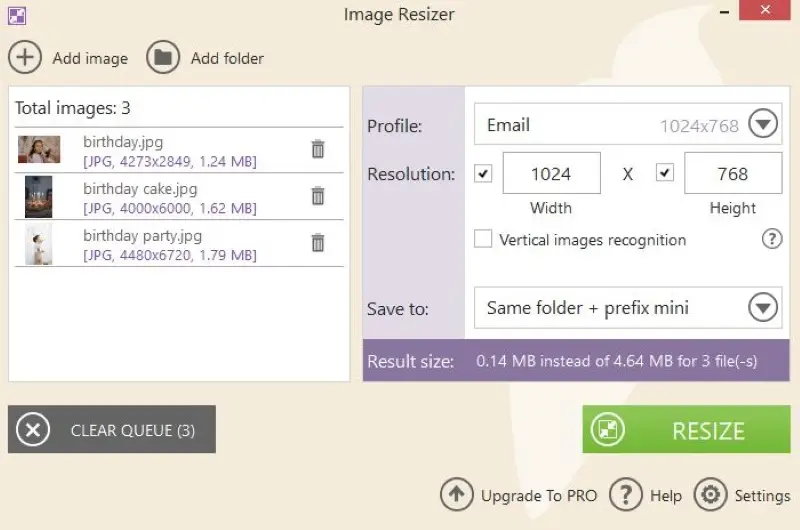
Pros:
- Compatibility. The image resizer supports popular formats such as JPG, PNG, BMP, TIFF, GIF, and more.
- Vertical image recognition. Enable this option if you're working on vertical and horizontal images at once. The width and height values will be switched automatically.
- Organization. You can save new files to the same folder with the "mini" prefix in the file name or overwrite the original pictures.
- Presets. You can resize the photos in bulk for Facebook, Twitter, Instagram, email, and more.
- Size preview. After you select the resolution, the software will provide the estimated size of the output images.
- Speed. The batch photo resizer processes pictures much faster than other image editing programs.
- Quality. The application automatically adjusts and optimizes image quality for best results.
Icecream Image Resizer offers a convenient tool for easy batch photo resizing. Whether you are dealing with a few images or hundreds of them, this free photo resizer is designed to accomplish your needs quickly and effectively.
Method 2. Photoshop
Photoshop is a powerful photo editing software that enables users to swiftly change the image resolution of various files simultaneously. Resizing multiple photos with this software is an effective solution for prepping images for web sharing or printing.
How to batch resize various photos in Photoshop
- In Photoshop, click "Scripts" and "Image Processor" in the "File" menu.
- Select all the images you need to resize by choosing the "Select folder" option.
- Determine the output folder and the file format.
- Set the resolution (width and height) and quality between 0 (lowest) and 12 (highest).
- Click the "Run" button in the upper-right corner of the window. The software will save each photo based on the parameters set in the script.
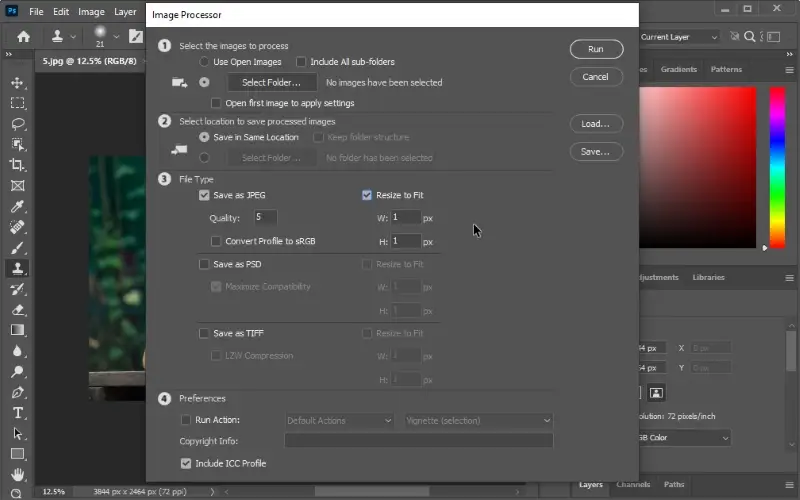
Pros:
- Automation. The action scripting allows you to record a sequence of steps, including batch photo resizing, and apply this recorded action later.
- Advanced features. Beyond just resizing, the program also allows you to sharpen, add filters, adjust colors, and use other tools.
- Format support. The bulk image resizer supports a wide range of formats, giving you the ability to batch resize almost any sort of image file.
Cons:
- Learning curve. For those not familiar with Photoshop, setting up batch processing can be a bit complex.
- Cost. This software is part of Adobe's Creative Cloud subscription, which is pretty expensive. You might want to use alternatives to Photoshop if you only need to batch resize the images occasionally.
- System resources. The software consumes a lot of system resources and can slow down your computer.
While the learning curve may be a bit challenging for beginners, using Photoshop to batch resize the pictures can be a significant advantage to professional users.
Method 3. GIMP
Applying GIMP is a great way to quickly and easily resize the needed photos in bulk. It allows you to make quick adjustments to the size of your images and save them all at once.
A step-by-step tutorial on using GIMP for batch photo resizing
- Install GIMP from the official website.
- Download the Batch Image Manipulation Plugin (BIMP). You can find it here. Restart the GIMP application.
- Select "Batch Image Manipulation" from the "File" drop-down menu.
- Click "Add Images" to import photos in bulk.
- Press the "Add" button and then "Resize". Enter the dimensions in percentages or pixels.
- Select the output folder and click "Apply".
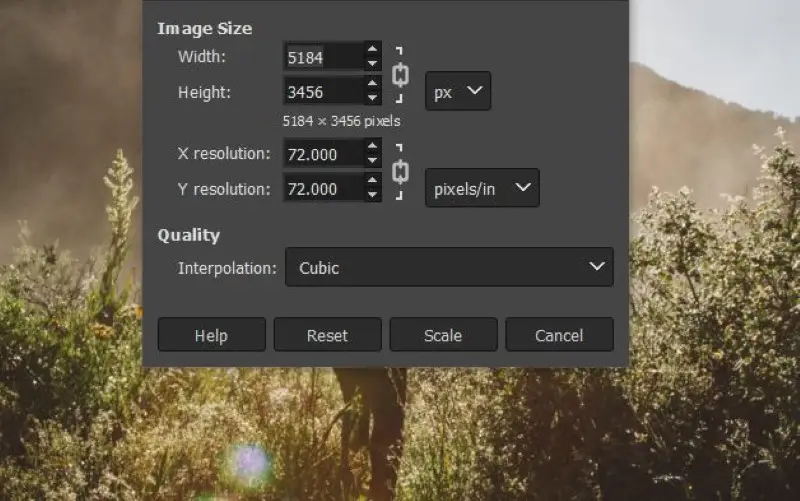
Pros:
- Free. The bulk image resizer is free and open-source, so you don't have to pay anything for it or worry about license restrictions.
- Versatility. The software offers a range of options to adjust image sizes. You can get exactly the results you want without compromising quality.
- Multi-platform. The program to batch resize the photos is available for many different operating systems, including Windows, macOS, and Linux, so you can use it regardless of your OS.
Cons:
- Learning curve. If all you need to do is batch resize images, then this method might prove more complicated than necessary.
- Limited support. If you get stuck, you are mainly reliant on community forums, tutorials, and troubleshooting resources.
In general, GIMP provides an economical solution for quickly scaling up or down multiple photos at once. With its wide range of features and free availability, it's definitely worth trying out if you need an efficient way to change the image resolution!
Method 4. iLoveIMG
Taking advantage of iLoveIMG's batch photo resizing feature is a simple way to change the resolution of multiple photos without having to install any software.
Guide on resizing multiple images at once with iLoveIMG
- Go to iLoveIMG and tap the "Resize Image" tool.
- Click "Select images" or drag and drop the photos into the window.
- Set the output settings by percentage or pixels.
- Press "Resize" to begin the process.
- Finally, download the resized pictures or upload them to a cloud storage.
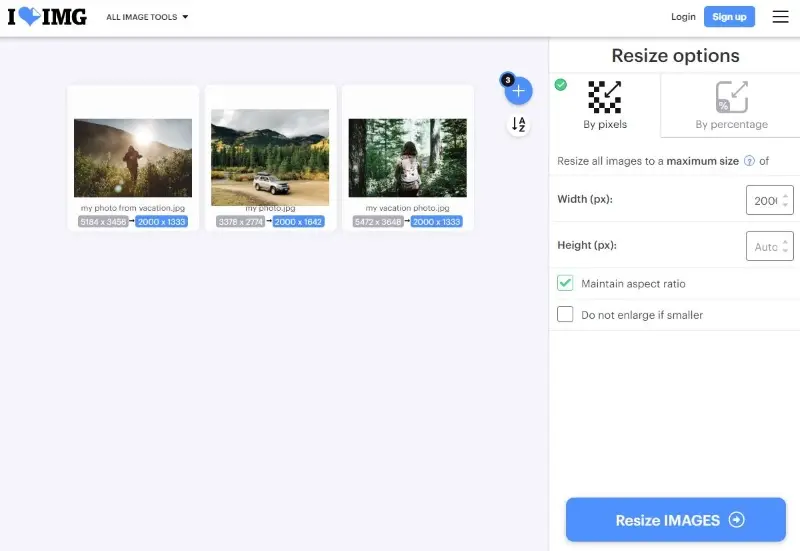
Pros:
- No installation is required. It's an online photo resizer, so you don't need to install anything. This makes it accessible from any device with an internet connection.
- Versatility. Not only can the service resize your images, but it also includes various other handy photo editing tools, such as cropping, compressing, or converting images.
Cons:
- Limitations. The free version allows to batch resize 30 pictures at a time. To process more photos, you will need to upgrade to the paid subscription.
Overall, using iLoveIMG to resize multiple images is a great option if you require swift and effortless service. However, professional photographers or designers may need something a bit more powerful or customizable.
Method 5. Fotosizer
Fotosizer enables efficient processing of numerous pictures simultaneously by changing them in bulk. Compatible with various formats like JPEG, PNG, and BMP, it accommodates diverse file types.
How to use the image resizer
- Obtain and install the app from its official source.
- Launch it on your device.
- Click "Add Images" or "Add Folder" to import the footage you wish to modify.
- In the options, pick your desired method:
- Scale by percentage.
- Define pixel dimensions.
- Fit footage within maximum width and height while preserving aspect ratio.
- Apply effects such as "Black & White", "Negative", or "Sepia" from the available filters.
- Pick a destination directory for the output.
- Hit "Start" to begin processing all imported photos simultaneously.
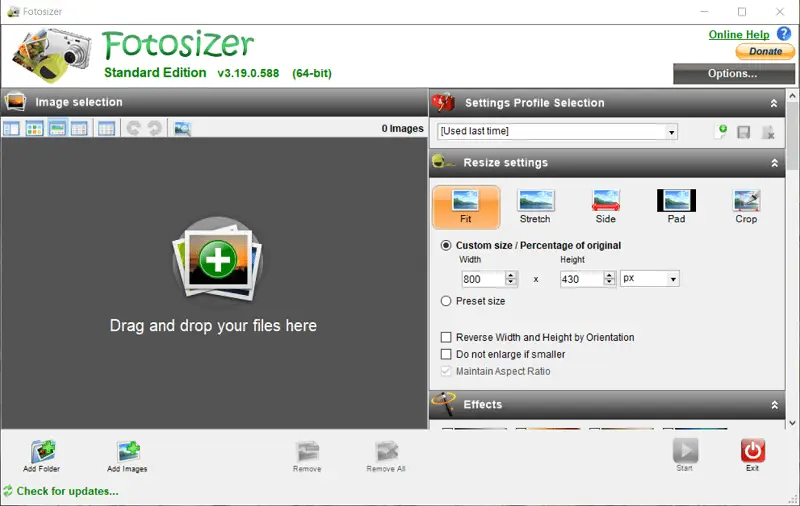
Pros:
- Additional editing features. Includes basic color adjustments, rotation, and watermark addition to enhance photos.
- Portable version available. Can be run without installation, useful for on-the-go use across devices.
Cons:
- No cloud integration. Limits collaborative workflows and remote storage options.
Its beginner-friendly interface simplifies task configuration, making the process accessible even to those without advanced expertise.
Resize vs. crop
| Feature | Resize | Crop |
|---|---|---|
| Definition | Adjusts the size of the entire image, either enlarging or reducing it. | Removes parts of the photo to focus on a specific area. |
| Aspect Ratio | Can change, depending on how the image is resized (e.g., stretching it). | Maintains or changes based on the selection of the area. |
| Use Case | When you want the full image visible but need to fit it within specific dimensions or constraints. | When you want to remove unnecessary parts and focus on a particular section of the photo. |
| File Size | Can result in larger or smaller sizes depending on how the picture is resized (enlarging may increase file size). | File generally remains constant unless the cropped image is saved in a different format or resolution. |
| Image Composition | Keeps all visual elements but scales them, which might distort proportions. | Emphasizes a selected area, potentially improving visual balance. |
Resize:
If you have a 1000x1000 px image and you resize it to fit into a 500x500 px box, the image will be compressed, and its visual quality may suffer depending on how much it is reduced.
Crop:
If you have a 1000x1000 px photo and crop it to 500x500 px, only a portion of the original picture will be kept, focusing on the central or most important part, while discarding the rest.
FAQ on bulk photo resizing
- Will resizing multiple images at once affect the quality of my photos?
- Reducing the resolution can result in a loss of detail and sharpness. However, modern photo resizing tools use advanced algorithms to maintain as much quality as possible while resizing multiple photos.
- What do the dimensions and resolution mean in photo resizing?
- The dimensions of an image refer to its width and height, usually measured in pixels. The resolution is the density of pixels in the image, generally represented as PPI (Pixels Per Inch) or DPI (Dots Per Inch).
- What resolution should I use?
- It depends on your specific needs. Generally speaking, it's best to choose a resolution between 72-300 dpi for web images, 300-600 dpi for print pictures, and 600 dpi or higher for high-resolution photos.
- Can I choose a specific size for batch resizing?
- Yes, most resizing tools allow you to specify the final size you want your images to be. It could be a certain percentage of the original size or an exact number of pixels for height, width, or both.
- Can I batch resize photos in different formats?
- Yes, many apps allow you to resize images in different formats such as JPEG, PNG, GIF, and TIFF. In some cases, you can even convert the file format during the resizing process, making it convenient for working with various types of pictures.
Tips on how to batch resize photos
- Create a new folder for the resized images.
- Check the "Constrain proportions" option to make sure none of the photos are distorted when resizing multiple different images at once.
- For the web, it's recommended to use JPEG and PNG formats. If you're looking for high-quality print, a TIFF or a RAW format might be more appropriate.
- Back up your original images in case something goes wrong with the resized ones. Plus, you might want to start from scratch with them later.
- Organize the files clearly by naming folders according to their contents so they're easy to find when needed.
Conclusion
It's clear that learning the process of using batch photo resizers can make your life easier. Especially if you work with large volumes of images frequently. This not only saves time and effort but also ensures consistency.
With these steps in mind, you should be able to batch resize photos without any problem. Whether you are resizing for the web, social media, or professional print, using the tools described in this article will enhance your overall productivity.


